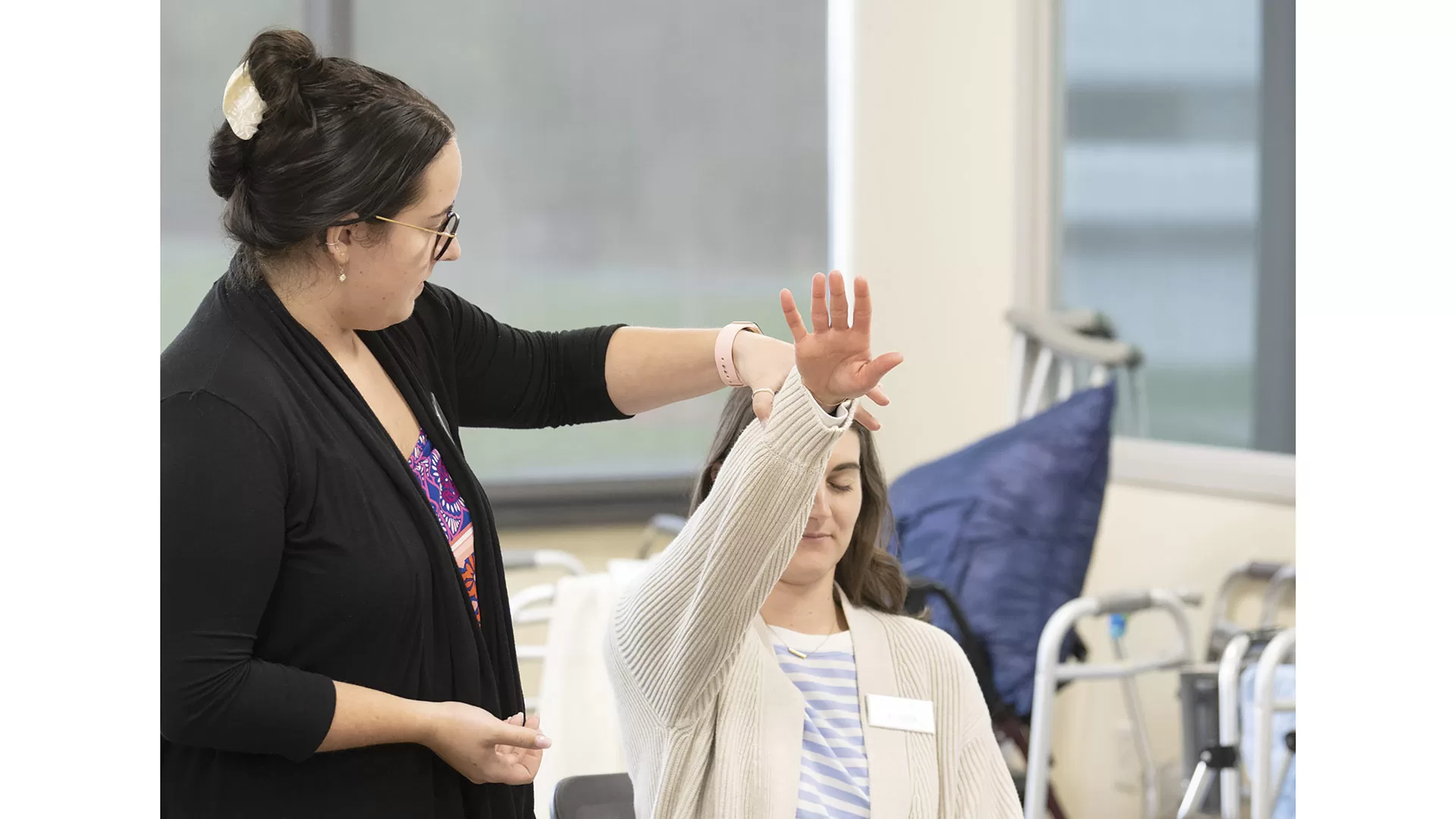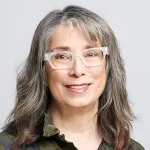
Bay Path Program Addresses Productive Aging
Golden Opportunity

While the OT programs at Bay Path involve plenty of classroom time (as pictured here), students are doing innovative work in the community as well.
Photo by Leah Martin Photography
When Dr. Julie Watson arrived at Bay Path University, she recognized a rapidly growing population in need of occupational therapy: senior citizens.
So Watson — who directs Bay Path’s health science doctorate, master of public health, and post-professional occupational therapy doctorate programs — had an idea to enrich the post-professional OT doctorate program, which is for working occupational therapists seeking their clinical doctorate while they practice.
“Given my experience with older adults and caregivers, I saw a need to have something that focuses on the aging U.S. population. Almost a quarter of the population is going to be older than age 65 by 2030.”
So she developed a concentration for the OTD program called productive aging. “It focuses on the idea that older adults can remain active and productive even as they’re aging — that we can maximize the independence of older adults so they can stay in their homes and continue to engage in activities that are important to them, whether that’s working part-time or volunteering or spending time with their grandkids or even leisure activities like gardening.”
As noted, the track started as a concentration for the post-professional OTD program. “Then we launched a doctor of health science degree, and I wanted to incorporate the concentration into that as well. Then we had a re-evaluation of our master of public health program. And what’s more public health than a population-based approach for older adults?
“So it became an interdisciplinary concentration,” she explained, “where students from a variety of backgrounds can come together and take four courses that prepare them to address these needs of a lot of older adults in our communities.”
“It focuses on the idea that older adults can remain active and productive even as they’re aging — that we can maximize the independence of older adults so they can stay in their homes and continue to engage in activities that are important to them, whether that’s working part-time or volunteering or spending time with their grandkids or even leisure activities like gardening.”
Those four course descriptions go a long way toward explaining how the concentration puts the ideas behind productive aging to use in the community, to help older people maximize their independence and quality of life:
• “Aging in Place” examines supports to keep people in their homes, maintaining their independence in the community — and also barriers that prevent them from doing so.
• “Chronic Disease Management for Older Adults” acknowledges that older adults are faced with many chronic diseases, from congestive heart failure to cancer, and discusses strategies to help them with their chronic conditions, to improve their outcomes and their quality of life.
• “Specialized Assessment” takes a public-health approach to evaluating communities — and the services available in those communities — to make sure they’re meeting older adults’ needs when it comes to infrastructure and programs in place to support older adults.
• Finally, “Neuroscience of Aging and Impact on Mental Health” examines the neurological changes that can happen with older adults, including cognitive impairment and Alzheimer’s disease.
“I love working with older adults so much. When I was a clinical OT, I enjoyed that specific aspect of my practice,” Watson said, noting that most Baby Boomers coming from hospital care or simply dealing with normal aging want to stay in their homes, which has led to a boom in home care.
Dr. Julie Watson
“It’s a win-win because students are getting the experience working with older adults, and the older adults are getting much-needed services that allow them to remain independent and have a higher quality of life.”
“I think we’re poised for a shift in how we meet the needs of older adults; we want to be educating the practitioners, the healthcare professionals, about these needs in advance.”
Changing Times
In a widely read article last fall, the the New York Times editorial board addressed these growing needs.
“Thanks to falling birth rates, longer life expectancy, and the graying of the Baby Boomer cohort, our society is being transformed,” the editorial board wrote. “This is a demographic change that will affect every part of society. Already, in about half the country, there are more people dying than being born, even as more Americans are living into their 80s, 90s, and beyond. In 2020, the share of people 65 or older reached 17%, according to the Census Bureau. By 2034, there will be more Americans past retirement age than there are children.”
The purpose of the article was partly to call attention to the economic impact of the shift. In Japan, for instance, declining births combined with a surging senior population has caused a wave of school closings, labor shortages, and a steep drop in revenue for retirement programs, causing Japanese people to increasingly work into their 60s and 70s. But the writers also noted opportunities when it comes to the business of aging.
“A cottage industry of products and services has emerged to help people adjust their homes and their lives for aging. A demographic shift this significant calls for a broad-based response, and the longer the challenges go unaddressed, the more formidable they become,” they wrote. “There are many pieces to this puzzle, including who will care for older people, where they will live, how our cities are designed, and how businesses will adapt.”
One barrier, of course, is funding, Watson noted.
“You’re dealing with federal, state, city, and county budgets, and this isn’t a high priority in a lot of places,” she told BusinessWest. “So, the ideas are well-received, and public-health and healthcare professionals know they’re needed, but — aside from councils on aging in all our local communities — there hasn’t been a huge shift in funding for the types of services that are needed. But we need to make these things happen, and it would be great if we could see federal, state, and local investment money into this sort of thing.”
The students at Bay Path are already applying their education to the community in ways that are mutually beneficial. The master of occupational therapy students work with faculty at Ruth’s House, an assisted-living community in Longmeadow, and also participate in a monthly stroke support group at the Enfield Senior Center.
Nora Moreno Cargie
“We are inclusive and center the work in community. These initiatives originated with older people, including people of color, people from the LGBTQ+ community, and others facing systemic barriers, demonstrating the power of proximity and the creativity of community.”
The OT department has also held an event that helps older drivers adjust their cars for optimum safety, and OTD students do projects educating healthcare practitioners and families about services available in the community for older adults.
“When we have the students out in the community with practitioners,” Watson said, “it’s a win-win because students are getting the experience working with older adults, and the older adults are getting much-needed services that allow them to remain independent and have a higher quality of life.”
Age-friendly Developments
Bay Path’s heightened attention on aging reflects a national demographic shift that began a couple decades ago and continues today: a U.S. population whose average age is on the rise.
That reality inspired a podcast launched by the Healey-Driscoll administration last fall called ReiMAgine Aging, which aims to tell the story of the age- and dementia-friendly movement taking place in Massachusetts.
The podcast highlights efforts to make Massachusetts a better place to grow older, including updating infrastructure, promoting volunteer and employment opportunities, expanding affordable supportive housing, increasing transportation options, supporting caregivers, and improving digital access.
“Equity, access, and justice are foundational to the age- and dementia-friendly movement,” Secretary of Elder Affairs Elizabeth Chen said when the podcast was unveiled. “We are grateful to the older adults, caregivers, communities, and organizations who shape and lead this work and who have helped us reframe aging to be an asset.”
The podcast, accessible at mahealthyagingcollaborative.org/reimagine-aging, highlights voices from statewide and community leaders, older adults, and nonprofits through six episodes: “Aging with Purpose and Meaning,” “Buildings That Bring People Together,” “Enhancing Digital Equity for All,” “Moving Forward,” “Savoring Food That Matters,” and “Shaping Compassionate Communities.”
The podcast was produced in partnership with the Massachusetts Healthy Aging Collaborative with funding from Point32Health Foundation.
“The country is looking to Massachusetts as a leader in the age-friendly movement,” said Nora Moreno Cargie, Point32Health Foundation president. “We are inclusive and center the work in community. These initiatives originated with older people, including people of color, people from the LGBTQ+ community, and others facing systemic barriers, demonstrating the power of proximity and the creativity of community.”
At Bay Path, Watson is gratified to see faculty and students to do their part in creating that paradigm.
“The productive-aging concentration is very unique in higher education, and the fact that we have students at different levels who have the opportunity to develop programs and interact with people in the community while they’re learning … it’s just a special thing.”






